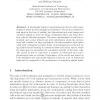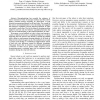181 search results - page 32 / 37 » State Space Reduction For Hierarchical Reinforcement Learnin... |
FLAIRS
2009
13 years 5 months ago
2009
In this paper, we investigate the hypothesis that plan recognition can significantly improve the performance of a casebased reinforcement learner in an adversarial action selectio...
PADL
2010
Springer
14 years 4 months ago
2010
Springer
Explanations are a technique for reasoning about constraint propagation, which have been applied in many learning, backjumping and user-interaction algorithms for constraint progra...
MIRRORBOT
2005
Springer
14 years 28 days ago
2005
Springer
Abstract. A biologically inspired computational model of rodent representation–based (locale) navigation is presented. The model combines visual input in the form of realistic tw...
ICML
1994
IEEE
13 years 11 months ago
1994
IEEE
Compositional Q-Learning (CQ-L) (Singh 1992) is a modular approach to learning to performcomposite tasks made up of several elemental tasks by reinforcement learning. Skills acqui...
IROS
2007
IEEE
14 years 1 months ago
2007
IEEE
— Neurophysiology has revealed the existence of mirror neurons in brain of macaque monkeys and they shows similar activities during executing an observation of goal directed move...


